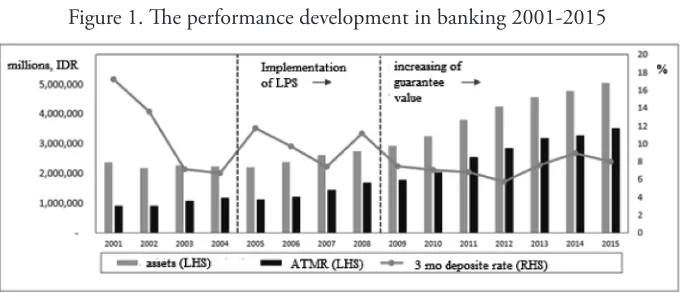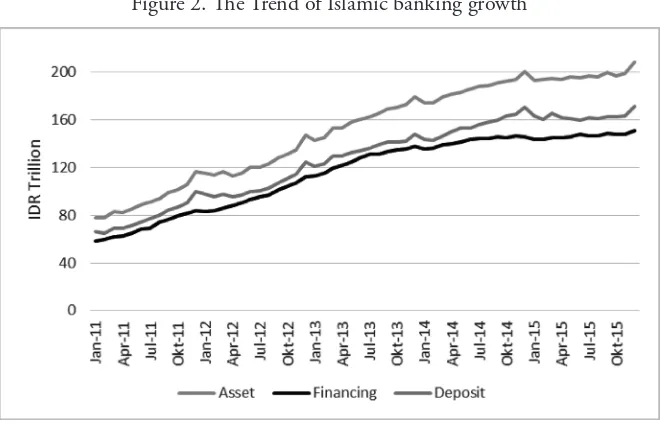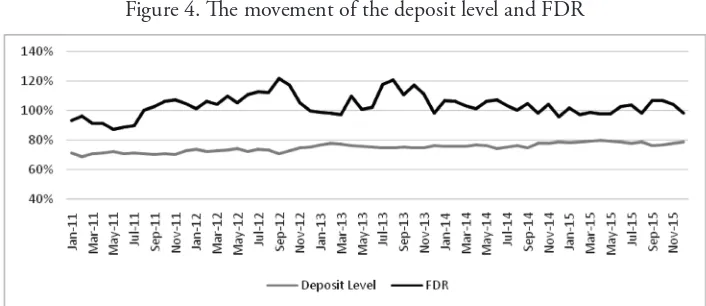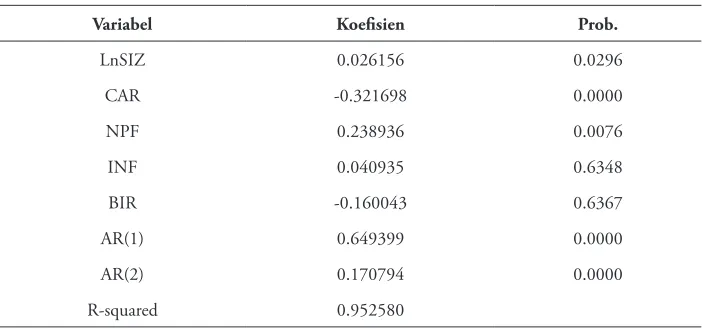Page 213 - 226
Received: March 16, 2017; Revised: April 30, 2017; Accepted: May 10, 2017
Abstract. Determining Factors of Deposit Level of Islamic Bank In Indonesia. One Way to maintain the stability of banking industry is by applying the deposit insurance scheme. The application of the deposit insurance scheme has an impact by increasing the level of bank deposits. The objectives of the research are to identify the factors affecting the level of deposits of Islamic banks in Indonesia and managerial implications regarding to the functions of Indonesia Deposit Insurance Corporation (LPS). The technique used is the panel data regression with ixed effect model using the data from the 11 Islamic banks for the period of 2011 -2015. The results show that the factors affecting the level of deposits of the Islamic banks in Indonesia signiicantly and positively include the size of banks and their non-performing inancing (NPF); however, they inluence the capital negatively. Based on these results, LPS is required to build or sharpen the surveillance systems as part of its early detection by doing the mapping based on the size and to monitor the bank capital structure and bank inance portfolio structure.
Keywords: Islamic bank, deposit level, panel regression.
Abstrak. Determinan yang Memengaruhi Tingkat Deposit Bank Umum Syariah di Indonesia. Salah satu cara untuk menjaga stabilitas industri perbankan adalah dengan menerapkan skema penjaminan simpanan. Penerapan skema penjaminan simpanan dapat meningkatkan tingkat deposit bank. Tujuan penelitian ini adalah untuk mengetahui faktor-faktor yang memengaruhi tingkat deposit bank umum syariah di Indonesia dan implikasi manajerial berkenaan fungsi penjaminan Lembaga Penjamin Simpanan (LPS). Tehnik yang digunakan adalah regresi data panel dengan metode ixed effect model dan menggunakan data 11 bank umum syariah pada periode 2011 -2015. Hasil penelitian menunjukkan bahwa faktor yang memengaruhi tingkat deposit bank umum syariah di Indonesia secara signiikan dan positif adalah ukuran bank dan non performing inancing (NPF), sedangkan permodalan berpengaruh secara negatif. Berdasarkan hasil tersebut, LPS perlu membangun atau mempertajam sistem pengawasan sebagai bagian dari early detection dengan melakukan mapping berdasarkan ukuran dan, melakukan pemantauan terhadap struktur permodalan bank dan struktur penyaluran pembiayaan bank.
Kata kunci: bank umum syariah, tingkat deposit, regresi data panel.
DETERMINING FACTORS OF DEPOSIT LEVEL OF
ISLAMIC BANK IN INDONESIA
Introduction
In 2015, the market share of the banking sector reached 78.62% from total inancial asset or equivalent to IDR 6.021 trillion of IDR7.658 trillion inancial asset. With the huge of asset share of banking industry, Goverment needs to keep the stability within the vast expansion in the banking industry. Kunt and Kane (2002) explain about some policies to stabilize the banking system, such as the prudential surveillance banking system, the deposit insurance function, and the function of the central bank as the lender of the last resort. Anginer et al. (2014) stated that the deposit insurance scheme had a stabilizing efect during the crisis period even though not in normal times.
Indonesia has already applied the deposit guarantee scheme during economic crisis in 1998. he guarantee program was continued by esthablishing a special agency through Law Number 24 in 2004 concerning Lembaga Penjamin Simpanan (LPS) or Indonesia Deposit Insurance Corporation (IDIC). he implementation of the deposit insurance scheme has successfully increased the public trust to the banking industry. It is shown by the rise in the deposit from the banking sector as can be seen in Figure 1, and this is inline with the research of Chernykh and Cole (2011) regarding implementing efect of deposit insurance scheme in Russia.
Figure 1. he performance development in banking 2001-2015
Source: OJK – Finansial Report (2001-2015)
In last 5 years, the Islamic banking industry has a positive growth (Figure 2). Alamsyah (2012) reported some factors that support the growth of Islamic banks. hose factors are: First, expansion of Islamic branch network. Second,
to provide the legal certainty to support Islamic market activities such as Law No.21 2008 concerning Islamic Banking and Law No.19 2008 concerning Islamic Obligation (Sukuk). he implementation of the new law increases the number of Islamic banks from 5 to 11 in only 2 years (2009-2011). Fahmi (2012) indicates that the Islamic banking is a complementary in the banking industry. hus, the growth in the conventional banking will lead to the development of the Islamic banking; furthermore, the conventional banking is not a substitution or a threat for the Islamic banking. Solihin (2015) emphasized the importance of the readiness of Indonesian Islamic banks in facing the ASEAN free market. Islamic banks in Indonesia should reduce the operational costs so it can be more eicient and grow well. he development of Islamic banking industry in industry after the spin-of policy is so rapid, although according to Al Arif (2015) the spin-of afect the eiciency declining.
Figure 2. he Trend of Islamic banking growth
Source: OJK & LPS – Bank monthly report (2016)
it will help Islamic banking grow and become an important player in the banking sector in Indonesia.
As mention above, it can be concluded that this research is useful for LPS to develop the monitoring system of Islamic banks in order to maintain banking system stability. In addition, this research also can be useful for banks to develop strategies to improve fundraising capabilities. his research will examine the characteristics and afecting factors of deposit level of Islamic Banks in Indonesia and managerial implications both for LPS as well as for banks regarding LPS function to maintain the banking system stability and strategies in collecting funds for banks.
Literatur Review
he basis of Islamic banking as a inancial institution has been known by Islam based on consepts in the holy Al-Quran while the form and the mechanism of the organisation are managed by the moslems (Muhamad, 2012; Karim, 2006). he concepts that are derived from the Al-Quran such as accountability are derived from Al-Baqarah 282-283, trust and justice are from Al-An’am 70 and An-Nisa 3, usury concept is from Al-Baqarah 275 and 278-279. he practices of those concepts have already been known since Muhammad reign (Karim, 2006). A few examples include the Makkah community that trusted their treasure to Muhammad (wadi’ah concept) and Zubair bin Awwam that prefered to receive the treasure in the form of loan (mudharabah concept).
from interest rate (riba), free from uncertainty (gharar), and free from gambling (maisir). Muhammad and Lestari (2015) emphasized the importance of guarantee for Islamic banking by basing on the contract speciied in Islamic jurisprudence rules. Based on the International Association of Deposit Insurer (2010), “Islamic deposit insurance is an arrangement to protect insured depositors against the loss of their insured Islamic deposits placed with Islamic banking institutions (IBIs) in the event of an IBI’s failure. In this regard, the system must be free from the elements that Islam strictly prohibits, such as interest, speculation, and gambling”. Kafalah bil ujr and takaful is main contracts that can be used in Islamic insurance scheme (CIBEST IPB, 2014).
Chernykh and Cole (2011) ind that bank membership in the deposit insurance system inluences the ability of the bank to collect funds (deposits). he other factor that has an efect to deposit insurance is capital; the increase in the capital will reduce the credit risk; therefore, it will raise the public trust to save their money in banks (Vale, 2011). Tsuru (2003) inds that there is a negative correlation between non performing inancing and deposit amount. Nuryantono et.al. (2016) found that there are only 3 of the 9 sectors that have non performing inancing ratios below average i.e. electricity, water and gas, as well as business services and social service sector. Lusian et al. (2015) sees that unoptimal collection of deposits as a source of increased non performing inancing. he capability of the bank to collect deposit is very crucial for its intermediary function. Siringoringo (2012) shows that the ownership structure, proitability, size and the capital structure have consequences to the banking intermediation function in Indonesia.
deposit guarantee is not shown to increase risk-taking in the form of a decrease in the composition of capital to assets or an increase in credit to the bank’s asset composition.
Widigdo et.al. (2016) in their study on business process engineering of funding in Islamic banking in Indonesia emphasized the need to remodel business process of collecting deposits through increasing the accessibility of prospective depositors and increasing the accessibility of existing in order to encourage saving habit. Wiranatakusuma and Duasa (2017) in their research related to the resistance of Islamic banking on external factors found that deposits and inancing have been standardized, thus describing its resistance. Additionally, some macro-economic indicators such as M2/reserves, credit growth, real efective exchange rate, and inlation rates empirically become the key indicator of susceptibility signals.
Method
his research analysed the bank monthly reports of the 11 Islamic banks for the period of 2011-2015. he sources of the report come from OJK, BI, LPS, and/ or other Islamic Banking Institutions. he research was conducted from August 2016 to October 2016. It used panel data regression to analyze the data. he data set consisted of cross section and time series data (Greene, 2003). he cross section data are showed by the data consisting of more than one entity (individual) while the time series data are represented by any individual who has more than one period observation. he regression model tested in this research and the description of th variables will be as follows:
YTKD
i,t = αi,t + β1lnSIZi,t + β2CARi,t + β3NPFi,t + β4INFi,t + β5BIRi,t + ε
Table 1. he description of the variables
Variables Description Measurement
he size of the bank (SIZ)
he size of the bank is seen from its individual total asset which shows its ability to perform the business.
Natural logarithm from Rp million
Capital (CAR) Capital is the inancial capability of each individual
Islamic bank to absorb risks, including the inancing risk. he parameter of capital is Capital Adequacy Ratio (CAR).
Percentage
Non performing inancing (NPF)
Non-performing inancing reveals the risk of Islamic inancing by comparing between the non-performing inancing and total inancing.
Inlation (INF) Inlation is the condition where prices increase continuously. he price consumer index is the common indicator for this variable.
Percentage
he changing in BI rate (BIR)
BI rate is the policy rate issued by BI. It indicates the monetary policy.
Percentage
Deposit level (TKD) he comparison between the total deposit and the asset.
Result and Discussion
Deposit and inancing can be used to determine the level of resilience of Islamic banking (Wiranatakusama and Duasa, 2017). he development of Islamic banks in the period of 2011 - 2015 has generally a positive growth with compund annual growth rate of 3 (three) major components is 12.27% (assets), 12.51% (inancing) and 11.45% (deposits). Nevertheless, in 2014 and 2015 as can be seen in Figure 3 and Table 2, inancing on average fell signiicantly to 6.04% and 3.46% compared to 2012 (34.41%) and 2013 (22.26%) and experiencing slowing growth. his is partly due to the uncertainty in the economy and global inancial markets caused by the slowing global economic recovery.
Table 2. Yearly compound annual growth rate (%)
2012 2013 2014 2015
Asset 25.74 22.08 11.92 3.84
Financing 34.41 22.26 6.04 3.46
Deposit 24.81 18.89 15.56 0.27
Source: OJK & LPS – Bank monthly report, 2016
Figure 3. Growth of 3 (three) Main Indicator of Islamic Banks
Source: OJK & LPS – Bank monthly report, 2016
A bank has a good intermediary function if it has the ability to collect fund and distribute it for inancing. he intermediary ability is measured by Financing to Deposit Ratio (FDR). Based on the data during the observation, the lowest average of FDR was 87.12% in May 2011 and the highest was 121.87% in September 2012. In some period, the FDR of Islamic banks was fullil the requirement level of FDR according to the Regulation of Bank Indonesia No. 15/16/PBI/2013 on Reserve Requirement in Rupiah and Foreign Currencies fo Islamic Banks. he high level of FDR shows that the funding function cannot balance the aggresive inancing. he growth of the deposit level and FDR of Islamic banks can be seen in Figure 4.
Figure 4. he movement of the deposit level and FDR
In individually sight, Bank A as one of the biggest bank in assets has a good capability in collecting fund with value of the deposit level at 86.9%. his could be as the consequence of its massive oice and branches. In 2015, it had 865 channels with 136 main branches, 469 support branches, 50 mortgage oices, 60 cash outlets, 145 payment points, and 5 service points. Mean while Bank X as one of the smallest bank in assets has the highest FDR rate with value of 205.55%. he high level of FDR shows its inability to collect fund as represented by its low deposit level with only 33.6% which is due to lack of oice and branches. hus, this bank uses money market and its own capital for its funding source. his is inline with the research of Almejyseh and Rajha (2014) who considered that the amount of branches is one of the important parameters afecting customer deposits. Masamba et al. (2014) emphasized the importance of increasing the number of deposits by entering new markets through branch expansion, low-cost account products, and increase in returns on deposits.
Based on the classical assumption tests (Chow Test, Hausman Test, and Autocorrelation Test), Fixed Efect Model is the model that is applicable for this research. Table 3 presents the regression result according to this model.
Table 3. he regression result for the deposit level
Variabel Koeisien Prob.
LnSIZ 0.026156 0.0296
CAR -0.321698 0.0000
NPF 0.238936 0.0076
INF 0.040935 0.6348
BIR -0.160043 0.6367
AR(1) 0.649399 0.0000
AR(2) 0.170794 0.0000
R-squared 0.952580
*Signiicant at 5%
assets, capital, and non-performing inancing; however, inlation and BI rate are insigniicant. he result also obtained a signiicant inluence of the occurrence in the previous time or known as Autoregresive (AR) which is marked with AR (1) and AR (2). he autoregresive explains that the deposit lavel is afected by the values on factors occurring in the previous 2 (two) periods (in this case 2 months prior to January 2011).
Speciically, the variable of aset bank with score of 0.02615 is signiicantly inluential. he value of the asset has been made in the natural logarithm so it presents that every 1 % increase in aset will increase the level of deposit in 0.026%. Based on data from bank reports, it is found that the average ability to raise funds for the 4 largest banks in asset ranges from 81.15% to 86.99%. Meanwhile for the 4 banks with the smallest in asset are between 33.62% to 75.33%. he variable of aset has become attractiveness factor for depositor to place their funds in well established Islamic banks rather the new one. his is explain the large gap between main Islamic banks with others. Banks with a big number in asset will have a large number of branches and it will impact on accessibility for depositor and much easier for the bank to collect the fund. his result is diferent from the research of Rokhim and Wulandary (2012).
CAR is the other variable that signiicantly inluences the level of deposit variable in a negative way with score of 0.321698. It presents that every 1% increase in CAR, the level of deposit will decrease by 0.32%, this result is inline with Rokhim and Wulandary (2012). During the observation period, the CAR of Islamic banks is high since there are capital injection from shareholders as part of fulillment of regulation related to minimum capital of Islamic bank. Based on data from bank reports, the highest on CAR ratios dominated by the smallest banks in asset with average ranging from 36.40% to 70.84%. his is as a result from inability of the banks to disburse inancing. It should provide security for depositor because banks have suicient capital reserve to prevent banks from default. Nevertheless, additional capital from shareholders also gives a negative signal to depositors with increased control of shareholders who can lead banks to generate greater proits. his increases the risk of moral hazard which could be a negative signal for depositors to place funds in the banks.
has a strong believes that the bank is able to manage the NPF ratio and it shown by the average net NPF ratio of 1.50%. In addition, depositors also recognize the additional capital injection by shareholders although it also raises shareholder inluence on the bank. hus, the high rate of NPF has no impact for the depositors. Furthermore, despite having a high NPF, some banks attempt to collecting funding through sweeteners programs such as prizes or product champion (hajj savings).
Beside those signiicant variables, the external variables are insigniicant, such as inlation rate and BI rate. hey do not signiicantly inluence the level of deposit because of a number of factors. First, in monetary transmission theory, the BI rate variable is expected to afect the distribution of inancing which in turn will afect investment consumption (gross domestic product) thus keeping the inlation rate stable. Nevertheless, the results indicate that the two variables have no signiicant efect which is possible because of Islamic banking market share is minor compared to that of the conventional banking i.e. 4.7%. Hence, the diferences in those two variables have no efect on the depositors to place their funds in Islamic banks. Second, the awareness of Islamic bank customers to comply with sharia rules and avoid riba. Furthermore, the diversiication in inancial instruments as alternatives is another factor that is not signiicant to BI rate and Islamic bank deposit level such as sukuk (Novianto and Hadiwidjojo, 2013).
Conclusion
During the period of 2011-2015, Islamic banking experienced positive growth although the share asset was still low. Islamic banks has the ability to raise funds with the average ratio of deposit level of 68.70% - 79.91% and it channeled into the inancing sector with an average inancing deposit ratio of 87.12% - 121.87%. his inancing deposit ratio are in compliance with the provisions regulated by OJK.
products that are not insured based on de principles. hird, applying risk-based premiums is expected to be a disincentive for banks that not implement prudential banking.
References
Al Arif, M.N.R. (2015). Keterkaitan Kebijakan Pemisahan Terhadap Tingkat Eisiensi Pada Industri Perbankan Syariah di Indonesia. Jurnal Keuangan dan Perbankan, Vol. 19 (2): 295-304.
Alamsyah, H. (2012). Perkembangan dan Prospek Perbankan Syariah Indonesia: Tantangan dalam Menyongsong MEA 2015 [sambutan]. Bank Indonesia. Anginer A. et.al. (2014). How Does Deposit Insurance Afect Bank Risk? Evidence
from he Recent Crisis. Journal of Banking and Finance, 48: 312-321. Arshad, M.K. (2011). Implementation of an Islamic Deposit Insurance System
for he Islamic Financial Service Industry. Fourth Islamic Financial Stability Forum: Strengthening Financial Safety Nets in he Islamic Financial Service Industry. Kuala Lumpur.
Budisantoso, T & Nuritomo. (2014). Bank dan Lembaga Keuangan Lain (3rd Ed). Jakarta: Salemba Empat.
CIBEST IPB (Center for Islamic Business and Economic Studies Institut Pertanian Bogor). (2014). Pengembangan Skim Penjaminan Simpanan Industri Perbankan Syariah. Jakarta: Lembaga Penjamin Simpanan.
Chernykh, L. & R.A. Cole. (2011). Does Deposit Insurance Improve Financial Intermediation? Evidence form Russian Experiment. Journal of Banking and Finance. 35 (2): 388-402.
Fahmi I. (2012). Dinamika Struktur Pasar dan Perilaku Bank Serta Dampaknya Terhadap Kinerja Industri Perbankan Syariah. (Unpublished Dissertation). Bogor: Institut Pertanian Bogor.
Ho, T.S. & A. Saunders. (1981). he Determinants of Bank Interest Margin: heory and Empirical Evidence. Journal of Financial and Quantitative Analysis 16: 581-600
Karim AA. (2006). Bank Islam: Analisis iqih dan keuangan. Jakarta: PT Raja Graindo Persada.
King R.G. & R. Levine. (1993). Finance and growth: Schumpeter might be right.
he Quarterly Journal of Economics.108 (3): 717-737.
Lusian, S. et.al. (2015). Analisis Faktor-faktor Penyebab Pembiayaan Bermasalah di Bank Pembiayaan Rakyat Syariah CYZ periode 2009 – 2013. Finance and Banking Journal. 16 (1): 17-37.
Muhamad. (2012). Dasar-Dasar Keuangan Syariah. Yogyakarta: Ekonisia.
Muhammad, D.W. & A.Y. Lestari. (2015). Konsep Pengaturan Penjaminan Simpanan Nasabah Pada Bank Syariah. Jurnal Media Hukum. 22 (2): 274-293.
Nasution, M.Y. (2012). Dampak Sistem Penjaminan Simpanan Terhadap Tingkat Deposit dan risk-taking Bank Umum di Indonesia Menggunakan Panel Data Analysis: Studi Empiris Periode 1995-2010. (Unpublished hesis). Jakarta: Universitas Indonesia.
Novianto, A.S. & D. Hadiwidjojo. (2013). Analisis Faktor-faktor yang Mempengaruhi Penghimpunan Deposito Mudharabah Perbankan Syariah di Indonesia. Jurnal Aplikasi Manajemen. 11 (4): 595-604.
Nuryantono, N. et.al. (2016). Kaitan Kondisi Makroekonomi Dengan Non-Performing Financing Berdasarkan Sektor Ekonomi pada Perbankan Syariah di Indonesia. Jurnal Keuangan dan Perbankan. 20 (1): 104-115.
OJK. (2015). Tinjauan Kebijakan OJK dalam Pengembangan Sektor Ekonomi Prioritas: Analisis Potensi dan Risiko Perbankan. Jakarta: Departemen Pengembangan Pengawasan dan Manajemen Krisis.
Rokhim, R. & N. Wulandary. (2013). Pengaruh Penjaminan Simpanan, CAR, dan NPL Pada Tingkat Deposit, Risiko Moral Hazard, dan NIM. Jurnal Ekonomi dan Keuangan. 17 (4): 468-485.
Siringoringo, R. (2012). Karakteristik dan Fungsi Intermediasi Perbankan di Indonesia. Buletin Ekonomi Moneter dan Perbankan. 15 (1):61-83.
Solihin. (2015). Analisis Kesiapan Perbankan Syariah Negara-negara ASEAN dalam Menghadapi Penerapan Masyarakat Ekonomi ASEAN Tahun 2015.
(Unpublished hesis). Bogor: Institut Pertanian Bogor.
Tsuru, K. (2003). Depositors’ Selection of Banks and he Deposit Insurance System in Japan: Empirical Evidence and Its Policy Implications. Discussion Paper Series 03: E-024. Research Institute of Economy, Trade and Industry.
Vale, B. (2011). Efects of Higher Equity Ratio on a Bank’s Total Funding Costs and Lending. Oslo: Norges Bank.




